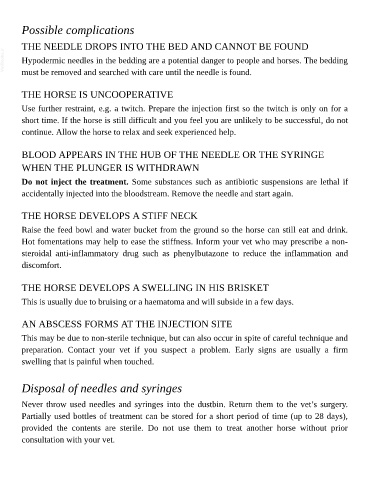Page 1135 - The Veterinary Care of the Horse
P. 1135
Possible complications
THE NEEDLE DROPS INTO THE BED AND CANNOT BE FOUND
VetBooks.ir Hypodermic needles in the bedding are a potential danger to people and horses. The bedding
must be removed and searched with care until the needle is found.
THE HORSE IS UNCOOPERATIVE
Use further restraint, e.g. a twitch. Prepare the injection first so the twitch is only on for a
short time. If the horse is still difficult and you feel you are unlikely to be successful, do not
continue. Allow the horse to relax and seek experienced help.
BLOOD APPEARS IN THE HUB OF THE NEEDLE OR THE SYRINGE
WHEN THE PLUNGER IS WITHDRAWN
Do not inject the treatment. Some substances such as antibiotic suspensions are lethal if
accidentally injected into the bloodstream. Remove the needle and start again.
THE HORSE DEVELOPS A STIFF NECK
Raise the feed bowl and water bucket from the ground so the horse can still eat and drink.
Hot fomentations may help to ease the stiffness. Inform your vet who may prescribe a non-
steroidal anti-inflammatory drug such as phenylbutazone to reduce the inflammation and
discomfort.
THE HORSE DEVELOPS A SWELLING IN HIS BRISKET
This is usually due to bruising or a haematoma and will subside in a few days.
AN ABSCESS FORMS AT THE INJECTION SITE
This may be due to non-sterile technique, but can also occur in spite of careful technique and
preparation. Contact your vet if you suspect a problem. Early signs are usually a firm
swelling that is painful when touched.
Disposal of needles and syringes
Never throw used needles and syringes into the dustbin. Return them to the vet’s surgery.
Partially used bottles of treatment can be stored for a short period of time (up to 28 days),
provided the contents are sterile. Do not use them to treat another horse without prior
consultation with your vet.

